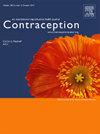Expanding contraceptive options: A scoping review of medically approved contraceptive methods that are not in the WHO Medical Eligibility Criteria
IF 2.3
2区 医学
Q1 OBSTETRICS & GYNECOLOGY
引用次数: 0
Abstract
Objectives
The World Health Organization’s (WHO) Medical Eligibility Criteria for contraceptive use (MEC) provides recommendations on the safety and efficacy of a range of contraceptive methods for users with various medical conditions. However, there are methods with medical regulatory agency approval that are not included in WHO guidance. Our objectives were to evaluate the evidence on methods that have regulatory approval for use in any member state, but which are not included in the MEC 2015, and to determine whether the evidence should be systematically reviewed to inform possible inclusion in a new WHO guideline.
Study design
We conducted a scoping review of experimental studies found through two bibliographic databases (PubMed, Embase) from database inception to December 2023. Two reviewers screened abstracts and full texts to determine eligibility based on a priori inclusion and exclusion criteria; one additional reviewer resolved conflicts. Reviewers extracted data on method safety, efficacy, and acceptability using a standardized tool.
Results
We identified three methods that met our review criteria: ormeloxifene, quinestrol-containing contraception, and mifepristone for emergency contraception (EC). Our initial search strategies yielded 386 total results. Five publications related to ormeloxifene, five to quinestrol-containing contraception, and 10 to mifepristone for EC were included. The data on these methods was highly variable.
Conclusion
Rigorous systematic reviews of the evidence on safety, efficacy and dosage of ormeloxifene, quinestrol-containing contraception, and mifepristone for EC are needed to inform WHO recommendations on these methods. As these methods are already being used, international guidance for practitioners is essential.
扩大避孕选择:对未列入世卫组织医疗资格标准的经医学批准的避孕方法进行范围审查。
目标:世界卫生组织(世卫组织)的避孕药具使用医疗资格标准(MEC)就各种医疗状况的使用者使用一系列避孕方法的安全性和有效性提出了建议。然而,有些经医疗监管机构批准的方法未包括在世卫组织指南中。我们的目标是评估在任何成员国获得监管部门批准使用但未纳入2015年MEC的方法的证据,并确定是否应该对证据进行系统审查,以便为可能纳入新的世卫组织指南提供信息。研究设计:我们对从数据库建立到2023年12月通过两个书目数据库(PubMed, Embase)发现的实验研究进行了范围审查。两名审稿人筛选摘要和全文,根据先验的纳入和排除标准确定是否合格;另外一个审稿人解决了冲突。审稿人使用标准化工具提取方法安全性、有效性和可接受性的数据。结果:我们确定了三种符合我们审查标准的方法:奥美洛昔芬、含喹雌酮的避孕方法和米非司酮用于紧急避孕(EC)。我们最初的搜索策略总共产生了386个结果。包括5篇与奥美洛昔芬有关的出版物,5篇与含喹雌酮避孕有关的出版物,10篇与米非司酮用于EC有关的出版物。这些方法的数据变化很大。结论:需要对奥美洛昔芬、含喹雌酮的避孕药具和米非司酮用于EC的安全性、有效性和剂量的证据进行严格的系统审查,以便世卫组织就这些方法提出建议。由于这些方法已经在使用,因此对从业者的国际指导至关重要。
本文章由计算机程序翻译,如有差异,请以英文原文为准。
求助全文
约1分钟内获得全文
求助全文
来源期刊

Contraception
医学-妇产科学
CiteScore
4.70
自引率
17.20%
发文量
211
审稿时长
69 days
期刊介绍:
Contraception has an open access mirror journal Contraception: X, sharing the same aims and scope, editorial team, submission system and rigorous peer review.
The journal Contraception wishes to advance reproductive health through the rapid publication of the best and most interesting new scholarship regarding contraception and related fields such as abortion. The journal welcomes manuscripts from investigators working in the laboratory, clinical and social sciences, as well as public health and health professions education.
 求助内容:
求助内容: 应助结果提醒方式:
应助结果提醒方式:


